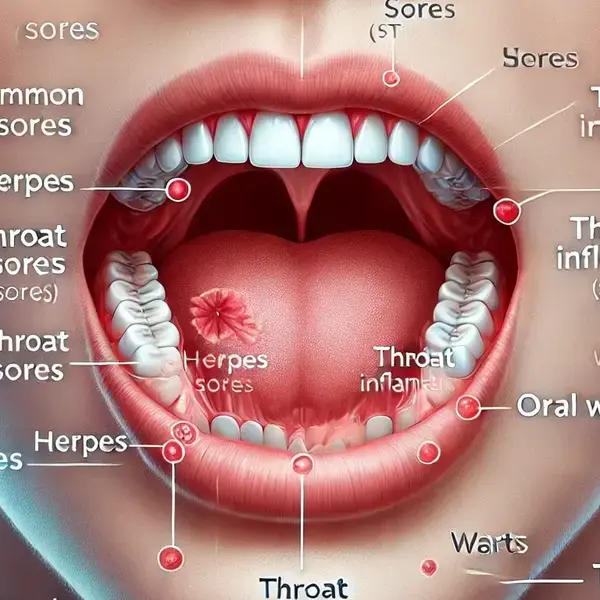When we think of sexually transmitted diseases (STDs), oral health isn’t usually the first thing that comes to mind. However, the mouth can be affected by STDs just as other parts of the body can. Oral STDs are a significant but under-discussed issue, largely due to a lack of awareness and common misconceptions. In this article, we delve into the statistics, symptoms, and medical insights surrounding STDs in the mouth, helping to provide an informed perspective.
The Prevalence of Oral STDs: What Do the Numbers Say?
Oral sexual contact is common, and so is the potential transmission of STDs through this route. Statistics show that about 85% of adults in the United States aged 18-44 have engaged in oral sex, and many are unaware of the associated risks. In fact, oral-genital contact is responsible for a growing number of STD cases, particularly among young adults.
According to the Centers for Disease Control and Prevention (CDC), around 13% of all gonorrhea infections and nearly 10% of all syphilis infections involve the throat or mouth. Oral herpes (HSV-1) affects around 50% to 80% of the U.S. adult population, though many people might not know they have it due to a lack of symptoms. These numbers underline how widespread oral STDs are, and why awareness is crucial.
| STD | Estimated Cases Involving Oral Symptoms | Common Symptoms |
|---|---|---|
| Herpes Simplex Virus | 50-80% of adults (HSV-1) | Cold sores, blisters |
| Gonorrhea | 13% of total cases | Sore throat, swollen glands |
| Syphilis | 10% of total cases | Oral sores, rash |
| HPV | Increasing prevalence | Warts, potential cancer risk |
Symptoms: What to Watch Out For
Oral STDs can manifest in various ways, making them easy to overlook or mistake for less severe conditions like a sore throat or cold sores. Key symptoms may include:
- Cold Sores or Blisters: Typically caused by HSV-1, cold sores are small, painful blisters that often form on the lips or inside the mouth. They may look like common mouth ulcers but are highly contagious.
- Sore Throat and Swollen Glands: Gonorrhea of the throat often presents as a persistent sore throat, which can easily be mistaken for a typical bacterial infection. Swollen lymph nodes are also a common indicator.
- White Patches or Oral Lesions: Syphilis can cause painless sores in the mouth, known as chancres, as well as white patches on the tongue or gums.
- Warts: Human Papillomavirus (HPV) can lead to oral warts, and while these are often painless, they can increase the risk of developing cancers of the throat or mouth.
Early detection and treatment of these symptoms are key to preventing complications. Because oral STDs can mimic other conditions, it’s important to seek medical evaluation if unusual oral symptoms persist.
Health Implications and Long-Term Risks
The health implications of oral STDs can be more severe than many realize. Oral HPV, for instance, is associated with an increased risk of oropharyngeal cancers—especially when combined with factors like tobacco use. This risk has been on the rise, particularly among men, with the American Cancer Society estimating around 54,000 cases of oropharyngeal cancers each year in the United States.
Syphilis, if untreated, can also progress to severe stages involving multiple organ systems. It is important to note that while the initial oral lesions may heal, the infection can silently progress within the body.
Treatment Options: What Are the Costs?
Most oral STDs are treatable, but early intervention is essential. The type of treatment will depend on the specific infection:
- Herpes (HSV-1): Antiviral medications like acyclovir or valacyclovir are commonly prescribed to manage outbreaks. Treatment costs can vary but typically range from $20 to $60 per prescription without insurance.
- Gonorrhea and Syphilis: Both conditions are treatable with antibiotics. For gonorrhea, a single dose of ceftriaxone costs around $50. Syphilis requires more intensive treatment, often with penicillin injections, which can cost approximately $150 to $300 depending on dosage and location.
- HPV: There is no direct cure for HPV, but warts can be treated with topical medications or removed surgically. Vaccination, which costs between $200 and $250 per dose, is the most effective preventive measure.
While these costs may seem significant, they are far less than the potential medical expenses of leaving an STD untreated. For example, the treatment for HPV-related cancers can reach thousands of dollars, not to mention the associated health burden.
Prevention: Stay Safe, Stay Informed
Prevention remains the best line of defense against oral STDs. Here are key strategies:
- Sexual Relations within Marriage: Engaging in sexual activity only within a committed marriage between a man and a woman significantly reduces the risk of contracting STDs. Mutual monogamy is one of the most effective ways to ensure sexual health.
- Barrier Methods: For those not in a committed marriage, using condoms or dental dams during oral sex can reduce the risk of transmitting or acquiring STDs significantly.
- Vaccinations: Vaccination against HPV is highly effective and recommended for both males and females starting at ages 11 or 12.
- Regular Testing: Routine STD testing is essential to ensure early detection and treatment. It is advisable to communicate openly with your spouse about sexual health and testing history.
Expert Advice from Our Editorial Team
Oral health is an integral part of sexual health. Given the prevalence and potential complications of oral STDs, awareness and proactive measures are essential. If you notice any unusual symptoms in your mouth, don’t dismiss them as just a cold sore or a sore throat—consult a healthcare professional. Early intervention can prevent serious health consequences, and regular check-ups are a crucial part of staying healthy. Remember, staying informed and cautious is the key to protecting your health and the health of those around you.
Meta Description: Discover key facts about oral STDs, including symptoms, statistics, and treatment options. Stay informed and protect your health. (116 characters)






